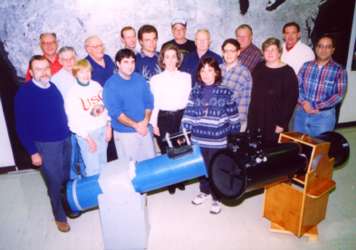History of the MVAS
by Carol Higgins
On May 31, 1989, seven amateur astronomers held an organizational meeting in the Solar Classroom at Hamilton College in Clinton, New York to plan the formation of an astronomy club. Bylaws were prepared and approved, and the Mohawk Valley Astronomical Society (MVAS) was born. Over the next several weeks, members prepared a brochure for prospective new members, discussed ideas for publicity campaigns to promote the club, and considered schedules for member and public observing sessions.
The first public meeting was held July 12, and the club was off to a good start. The previous day, an article appeared in the local newspaper (the Utica Observer-Dispatch) inviting the public to attend, and the local community responded heartily. The first meeting had 60 people in attendance! The evening's speakers presented slides and photographs of the sky's most noted features, from the Moon to distant galaxies, the Milky Way, Comet Halley as seen from the Mohawk Valley, and a brilliant aurora. Once the meeting adjourned, members and visitors used the telescope in Hamilton College's Observatory to view the Moon and Saturn.
August 1989 marked the first publication of the MVAS newsletter, Telescopic Topics.The newsletter is published monthly and provides a summary of the minutes of the previous month's meeting, reminders of upcoming observing sessions, and astronomy conferences as well as the latest news from the scientific community such as updates on NASA missions and the discovery of new celestial objects.
Except for April and July, meetings are held the second Wednesday of each month at 7:30 P.M. at the Kirkland Senior Center, Mill St., Clarke Mills, NY (see meetings). Each meeting features a main program, and we have been fortunate to have many interesting speakers who have covered a number of topics including the Hubble Space Telescope, meteorites, planets, radio astronomy, double stars, solar eclipses, Galileo and Cassini spacecraft, digital astro-imaging, the Sun and the latest news about NASA missions.
A portion of each meeting is reserved for "Member's Reports," where members share their projects, ideas, and viewing experiences. For example, several members are amateur photographers and have displayed their slides, 35mm and CCD photos of the Moon, comets, meteors, star trails, auroras, planets, clusters, galaxies, nebula, as well as visits to various observatories, astronomy shows, and conventions. Other members are quite artistic, and prefer to hand-sketch their observations.
 Over the years, members have been very busy participating in a variety of projects, committees, and observing sessions. Projects have included building a number of telescopes, solar filters, binocular mounts and stands, dust covers, a magnetometer for only $3 to predict auroras, an ingenious Solar Observatory contraption made with #14 welder's glass that fits over the head like a mask, and the ultimate example of patience - grinding telescope mirrors. One member even designed and built a computerized satellite tracking telescope. Several folks have earned Herschel and Messier certificates awarded by the Astronomical League.
Over the years, members have been very busy participating in a variety of projects, committees, and observing sessions. Projects have included building a number of telescopes, solar filters, binocular mounts and stands, dust covers, a magnetometer for only $3 to predict auroras, an ingenious Solar Observatory contraption made with #14 welder's glass that fits over the head like a mask, and the ultimate example of patience - grinding telescope mirrors. One member even designed and built a computerized satellite tracking telescope. Several folks have earned Herschel and Messier certificates awarded by the Astronomical League.
In 1999, members started work on an ambitious project -- building a sixteen-foot Ash Dome observatory. MVAS members volunteered many hours of their time to construct the observatory, and on November 26, 2002 the ultimate "finishing touch" was added: a 16-inch Meade LX-200 GPS Schmidt-Cassegrain telescope was installed! A formal celebration and dedication of the new Apollo Observatory was held June 6, 2003. The name was carefully selected to honor the role the dome played during NASA's Apollo Moon missions. For more information about the history of the dome, click here: The MVAS Apollo Observatory.
In 2012 the MVAS embarked on a unique partnership with the Waterville Public Library to construct an observatory on the library's grounds. The 16-inch LX-200 Seif Scope was moved to what is now known as the Barton-Brown Observatory (BBO) and other telescopes were added. For details about the BBO, click here: The Barton-Brown Observatory.
Our membership has grown to cover a large area in central New York, which includes the Utica area, Long Lake to the north, Syracuse to the west, West Winfield and Hamilton to the south, Little Falls and Sprakers to the east. We are an enthusiastic group of amateur astronomers. Our activities are dedicated to advancing the study, understanding, and appreciation of astronomy among members and the general public. We invite you to join us and share in the fun!
